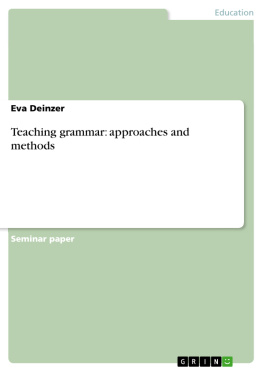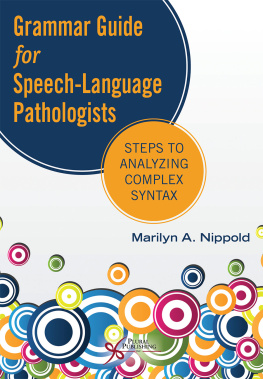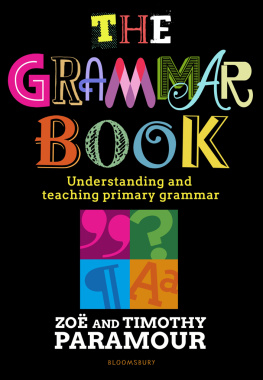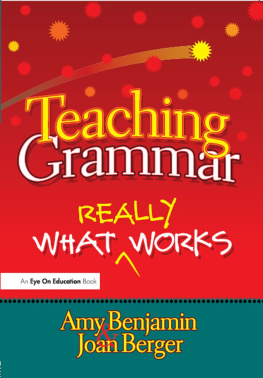Impressum:
Copyright (c) 2013 GRIN Verlag GmbH, alle Inhalte urheberrechtlich geschtzt. Kopieren und verbreiten nur mit Genehmigung des Verlags.
Bei GRIN macht sich Ihr Wissen bezahlt! Wir verffentlichen kostenlos Ihre Haus-, Bachelor- und Masterarbeiten.
Jetzt bei www.grin.com hochladen und weltweit publizieren.
Outline
1 Introduction
2 Is explicit grammar teaching really necessary?
3 Contrasting different approaches and methods
3.1 Grammar-Translation Method
3.2 Natural Approach
3.3 Consciousness-Raising
4 Other important aspects of grammar teaching
4.1 Deductive or inductive?
4.2 Error correction in speech
5 Constructing a model
6 Conclusion
7 Bibliography
1 Introduction
If you ask students what they dislike most in their foreign language classes you will not have to wait a long time for an answer. Mostly, the opinion will be unanimous: grammar. Grammar seems to be something which is hovering like a threatening cloud below the classroom ceiling. If the teacher accidentally let slip out that today's lesson will consist of grammar instructions, a murmur would be heard in the classroom which would be likely to express boredom or lack of interest. That is one reason why applied linguists and teachers alike are trying to find a way in which grammar could be taught both effectively and interestingly.
In my paper I would like to outline some topics concerning this matter, beginning with the important question if grammar teaching is actually necessary. After describing some approaches and methods in more detail and presenting briefly other important aspects in this regard, I will demonstrate my own model of grammar teaching. I know that this is a subject that could be discussed at full length but my intention is to give a short overview over important issues concerning grammar teaching.
2 Is explicit grammar teaching really necessary?
This question unleashed dozens of discussions which have not come to an end yet and probably never will. Before presenting some of them I would like to explain the difference between learning and acquisition of a language because it is important terminology which should not be confused. According to Stephen D. Krashen language acquisition is a process of subconsciously developing second language (L2) competence which is similar to the way children learn to speak their first language (L1). There is no conscious knowledge about rules we apply to when communicating but our feeling says that our utterances are produced in the right way. Language learning in contrast is the conscious knowledge of a second language. Learning means being taught the grammar and the rules about a language (1982: 10).
Mainly, there can be distinguished two opinions on that issue: either teach grammar or not. Krashen favors the so-called zero-option (Ellis 1997: 48) which does not focus on explicit grammar teaching at all, but which puts the emphasis on language acquisition through natural communication. To make his point of view clear, Krashen forms 5 hypotheses on how second language is acquired. The first one is called "The Acquisition-Learning Distinction" which I have already explained above. Then "The Natural Order Hypothesis" follows which simply means that children who acquire their mother tongue (L1) do so in a certain predictable order and so do acquirers of a second language. The kind of order, however, can be different. The third one is the "Monitor Hypothesis" which refers to learning about grammar rules only in order to use them as a monitor, i.e. if we know about certain rules we only use them to make necessary changes of an utterance before or after it is produced. Sensible Monitor use, though, depends on three factors: 1. You need sufficient time to think about and apply the rules, 2. you have to focus on the right forms and 3. you have to know the rules (Krashen 1982: 12-18). "The Input Hypothesis" is the fourth one and deals with the question "How do we acquire language?" (Krashen 1982: 20). The last one is called the "Affective Filter Hypothesis" and Krashen states here three factors which can be obstacles in the acquisition of a language: lacking motivation or self-confidence, and anxiety (1982: 31).
It is clear, for Krashen, that "learning does not 'turn into' acquisition" (1982:83) and that "language acquisition occurs when language is used for what it was designed for, communication" (1982: 1). The input hypothesis deals with the assumption that acquisition of L2 can be reached through communication, through comprehensible input. The main feature of that hypothesis is that acquisition takes place "when we understand language that contains structure that is 'a little beyond' where we are now" (1982: 21). Krashen defines the current knowledge of L2 as i and the next level which is to be acquired as i + 1. With the help of context and knowledge of the world an acquirer is able to understand natural communication which contains i + 1 (and possibly i + 2, i + 3 etc.). If this is the case then after sufficient input the acquirer automatically reaches the level i + 1. Of course, production - especially speech production - emerges not at once but "it 'emerges' over time [] when the acquirer feels 'ready'" (Krashen 1982: 22). To support the input hypothesis he compares it with L1 acquisition: The way the caretakers speak with little children who still have to acquire their first language is corresponding to the features of the input hypothesis. Caretakers are not interested in teaching language, but in talking to the child by using comprehensible input. Caretakers do not aim to convey a certain grammatical topic to a child but they use input in the form of i + 1, i + 2 etc. which then the child will acquire after a certain period of time (1982: 22-24).
As one can see Krashen is clearly against explicit grammar teaching by using a grammatical syllabus because he states that "[c]onscious knowledge of the rules is [] not responsible for our fluency, it does not initiate utterances" (1982: 83). He is in favor of acquiring the language implicitly and hence the grammar through a natural way. Together with Tracy D. Terrell he supports the so called Natural Approach to L2 acquisition which I will explain in more detail in chapter 3.
One representative of the counter-position is Rod Ellis, who highly doubts "that communication is sufficient for the acquisition of full grammatical competence" (1997: 55). He supports his claim by comparing various studies which dealt with L2 acquisition. He comes to the conclusion that the communicative classroom environment, which Krashen favors, does actually help students to develop a certain confidence in oral language production but that otherwise such a method is not appropriate to teach full grammatical competence (1997: 52). Especially for classroom learners this seems to be the case because it is very difficult to construct a communicative classroom environment which can fulfill all necessary premises for successful acquisition. Mostly there are too many students and the input they are receiving is not always comprehensible and often even imperfect (Ellis 1997: 51). Furthermore I would like to add that if a student lacks the motivation and the self-confidence which is - according to Krashen's input hypothesis - necessary to progress in an L2 and perhaps is anxious about making mistakes then the input hypothesis does not work and acquisition does not take place. What about those students? Ellis, furthermore, refers to studies which showed that grammar indeed can be acquired without form-focused instruction but only on elementary level. If the aim, however, is acquisition of higher grammatical structures a merely communicative classroom is not an option (1997: 54). For him form-focused instruction can lead to language acquisition but only if the effects of the instruction are durable. And this can only be achieved when learners receive "subsequent and possibly continuous access to communication that utilizes the features that have been taught" (1997: 66). For Ellis the communicative classroom and the zero-position are not sufficient to reach a high level of L2 competence and therefore he prefers the form-focused instruction of grammatical structures together with applying them in natural communication. In a relatively recent article he even concludes that - according to research from 2000 - "instruction contributes to both acquired knowledge [] as well as learned knowledge" (2006: 85). The studies he mentions there support his claim of teaching grammar explicitly. These two contrasting theories, among other things, have found their ways into different methods and approaches of second language acquisition (SLA) some of which I would like to explain in more detail in the next chapter.
Next page










